OWC USB Express 4M2
Support Manual
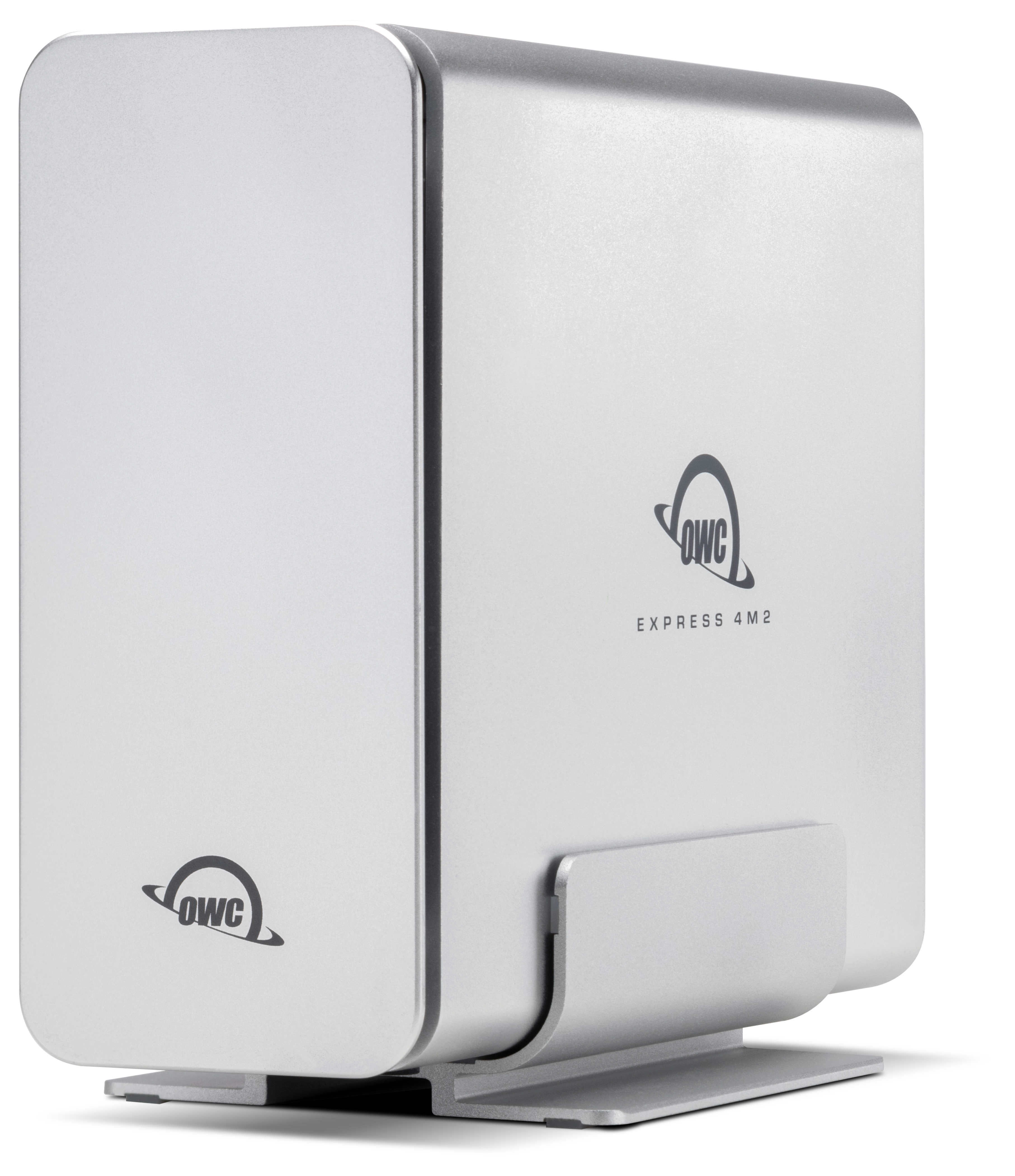
Introduction
1.1 System Requirements
Operating System & Hardware:
Works with any USB 3.2 Gen 2 (USB-C) and later | Thunderbolt 3 and later equipped:
- Mac: macOS 14.x or later
- USB4 40Gb/s Mode recommended for:
- Thunderbolt 5, Thunderbolt 4, USB4, and Thunderbolt 3 Intel based systems running macOS 15.x or later.
- USB 3.2 10Gb/s Mode recommended for:
- Intel based systems running macOS 14.x or earlier.
- USB 3.2 Gen 2 based systems.
- USB4 40Gb/s Mode recommended for:
- PC: Windows 10 or later
- USB4 40Gb/s Mode recommended for:
- PC systems running Windows 11 or later.
- USB 3.2 10Gb/s Mode recommended for:
- PC systems running Windows 10.
- Thunderbolt 3 | USB 3.2 Gen 2 based systems
- USB4 40Gb/s Mode recommended for:
- Linux: current version recommended
1.2 Package Contents
(1) OWC USB4 Express 4M2 External Enclosure
(1) 0.7M (28") USB-C 40Gb/s Cable
(1) Aluminum Vertical Stand
(1) External Power Supply
(1) US Power Cable (2-Prong IEC C7)
(1) 3 Years of SoftRAID Premium Access (with select solutions)
- (License located on device)
1.3 Overview
A. Power Status LED
- Connection = Solid Blue
B. Drive Bay A | B | C | D Status LEDs
- Connection = Solid Green
- Data Activity = Blinking Green
C. USB4 40Gb/s | USB 3.2 10Gb/s Mode Switch
- Toggle to change the device connection from the factory default USB4 40Gb/s connection type to a USB 3.2 10Gb/s connection type.
D. USB4 40Gb/s Host Port
- Connect to a compatible USB 3.2 Gen 2 (USB-C) and later | Thunderbolt 3 and later system
- USB 3.2 Gen 2 | Thunderbolt 3 (Windows) connections require toggling the USB4 40Gb/s | USB 3.2 10Gb/s Switch
E. DC IN 12V 4A Power Port
- Connect the power cable to power the device
F. Drive Bay Panel: Remove (4) panel screws to access drive bays.
- Please see Section 2.2 "Drive Installation" for instructions.
G. Aluminum Vertical Stand - OWC recommends attaching to stabilize the device while on a flat surface.
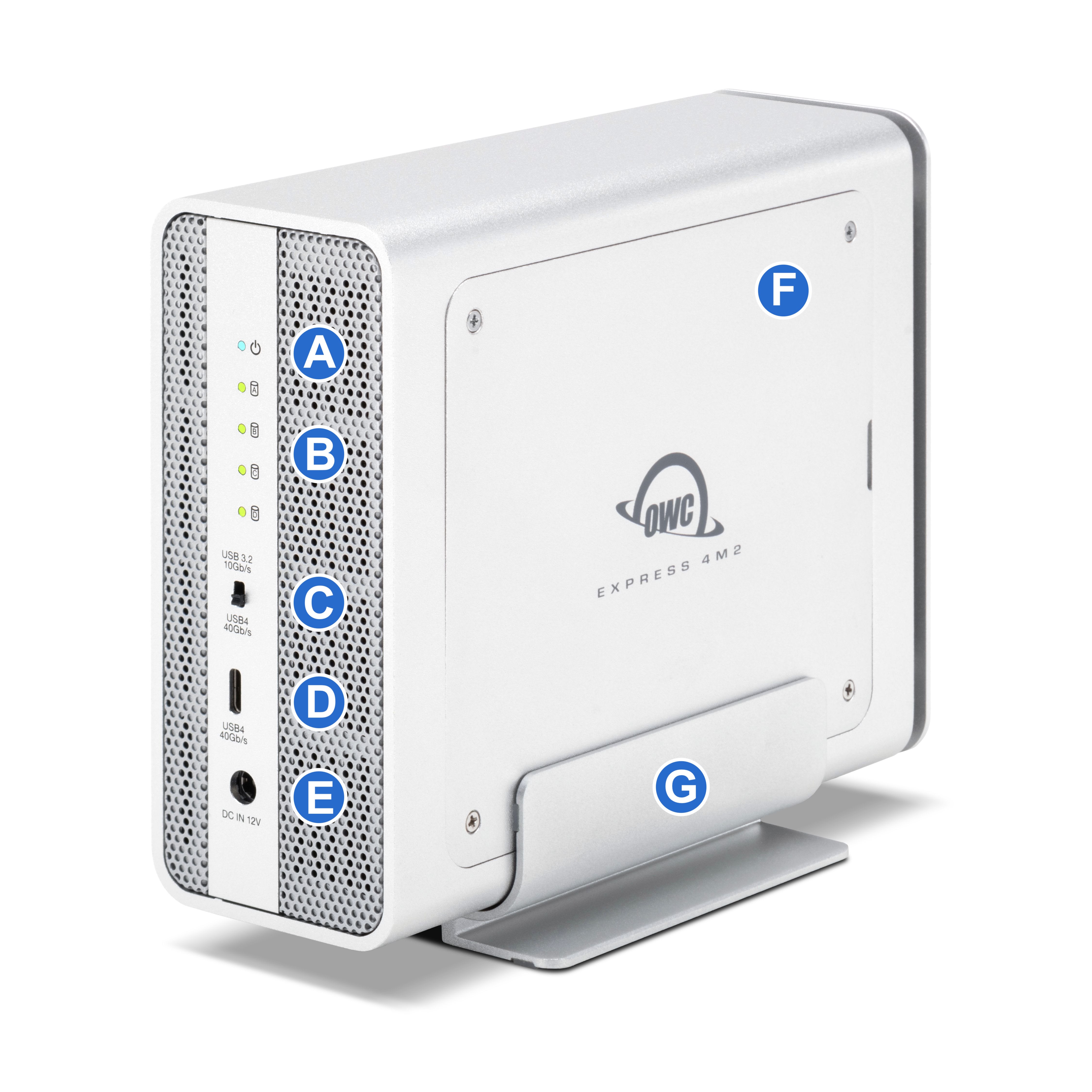
Getting Started
2.1 Drive Installation
- This section describes the process of installing (4) NVMe M.2 2280 | 2242 | 2230 SSDs into the OWC USB4 Express 4M2.
Opening the Enclosure
1. Place the OWC USB4 Express 4M2 on a flat static free surface with the drive bay panel facing upwards.
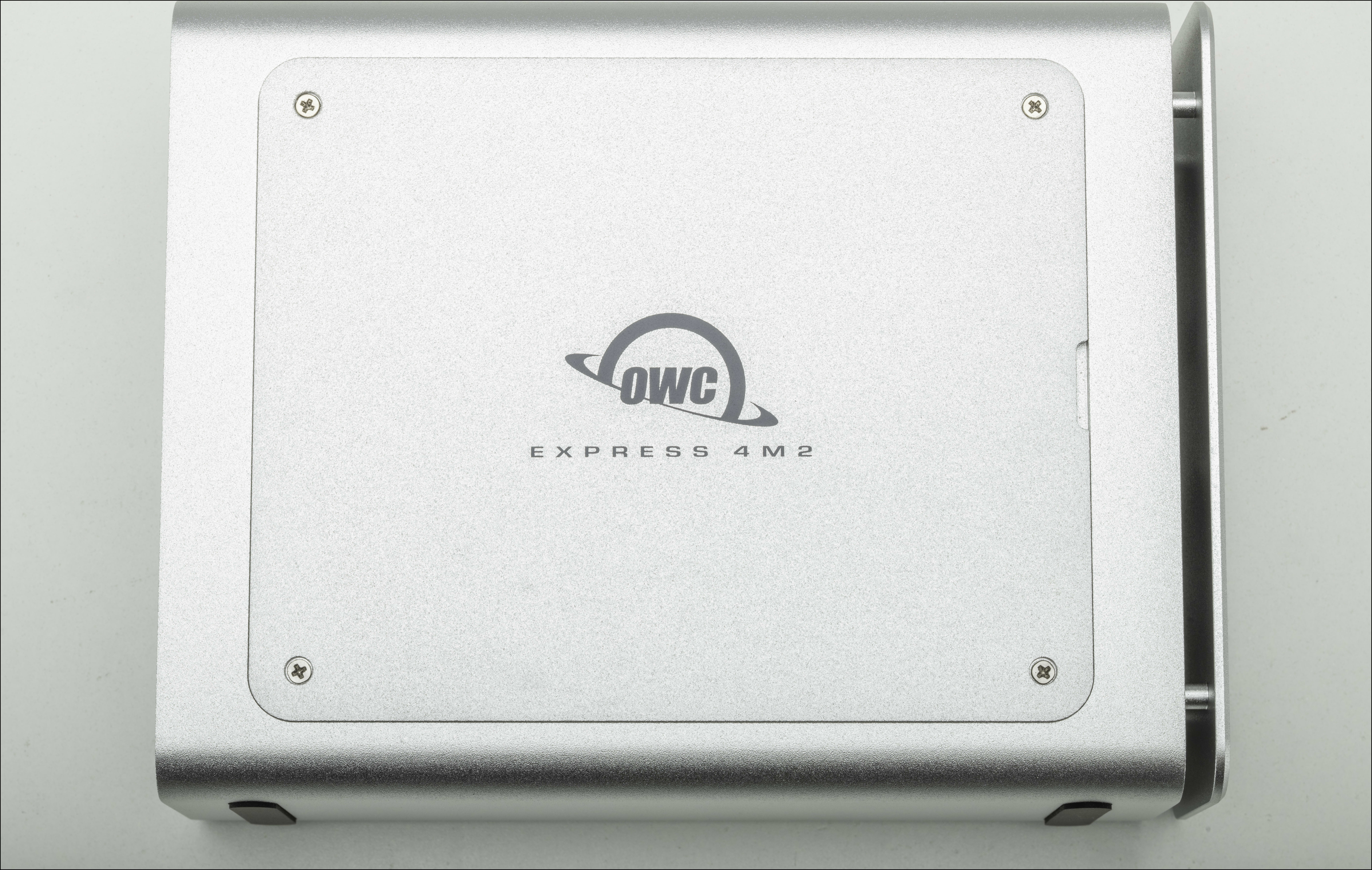
2. Remove the (4) exposed drive bay panel screws with a screwdriver (included in baggie).
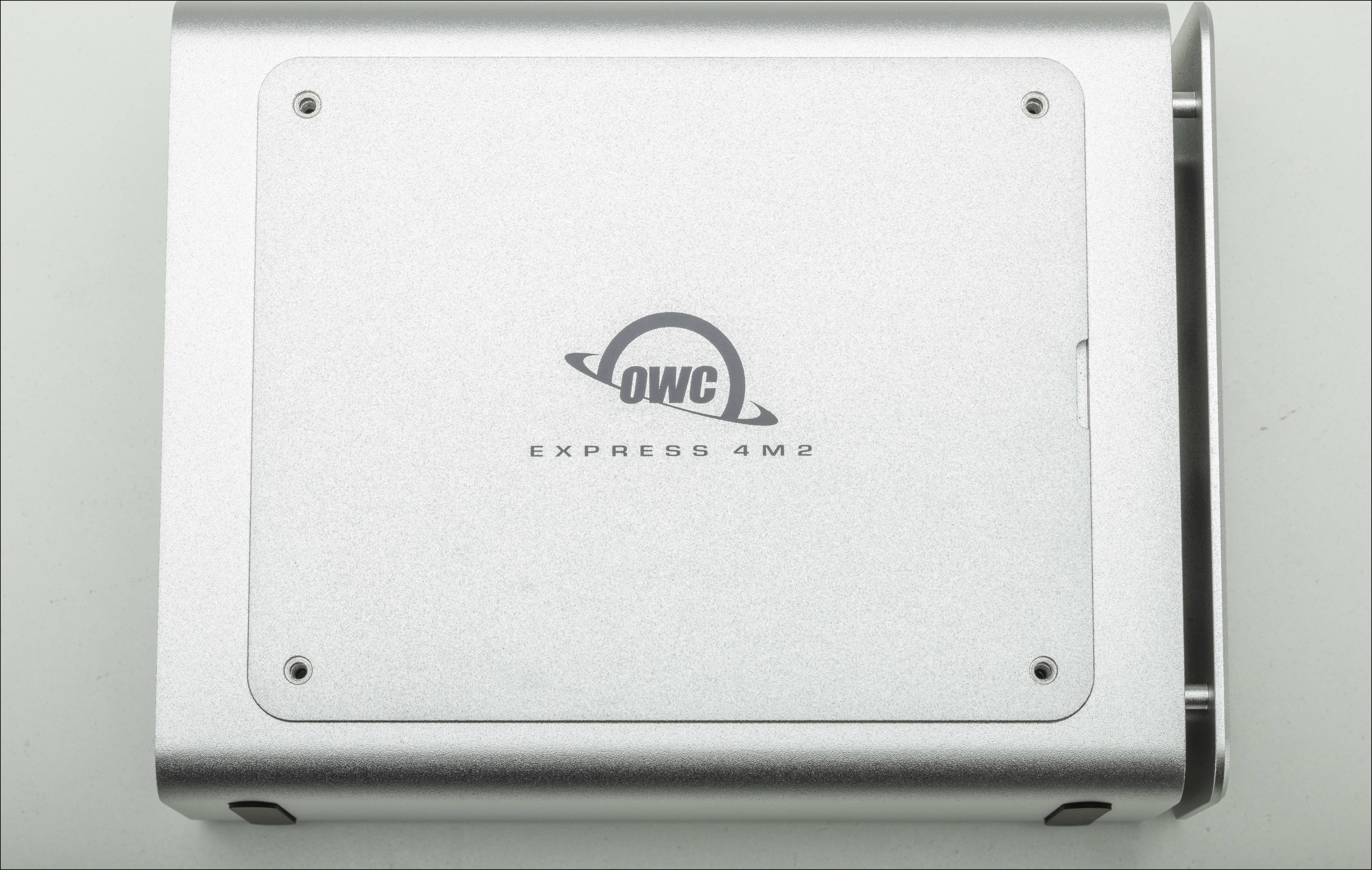
3. Place a nylon pry tool (included) into the drive bay panel notch to assist with lifting underneath.
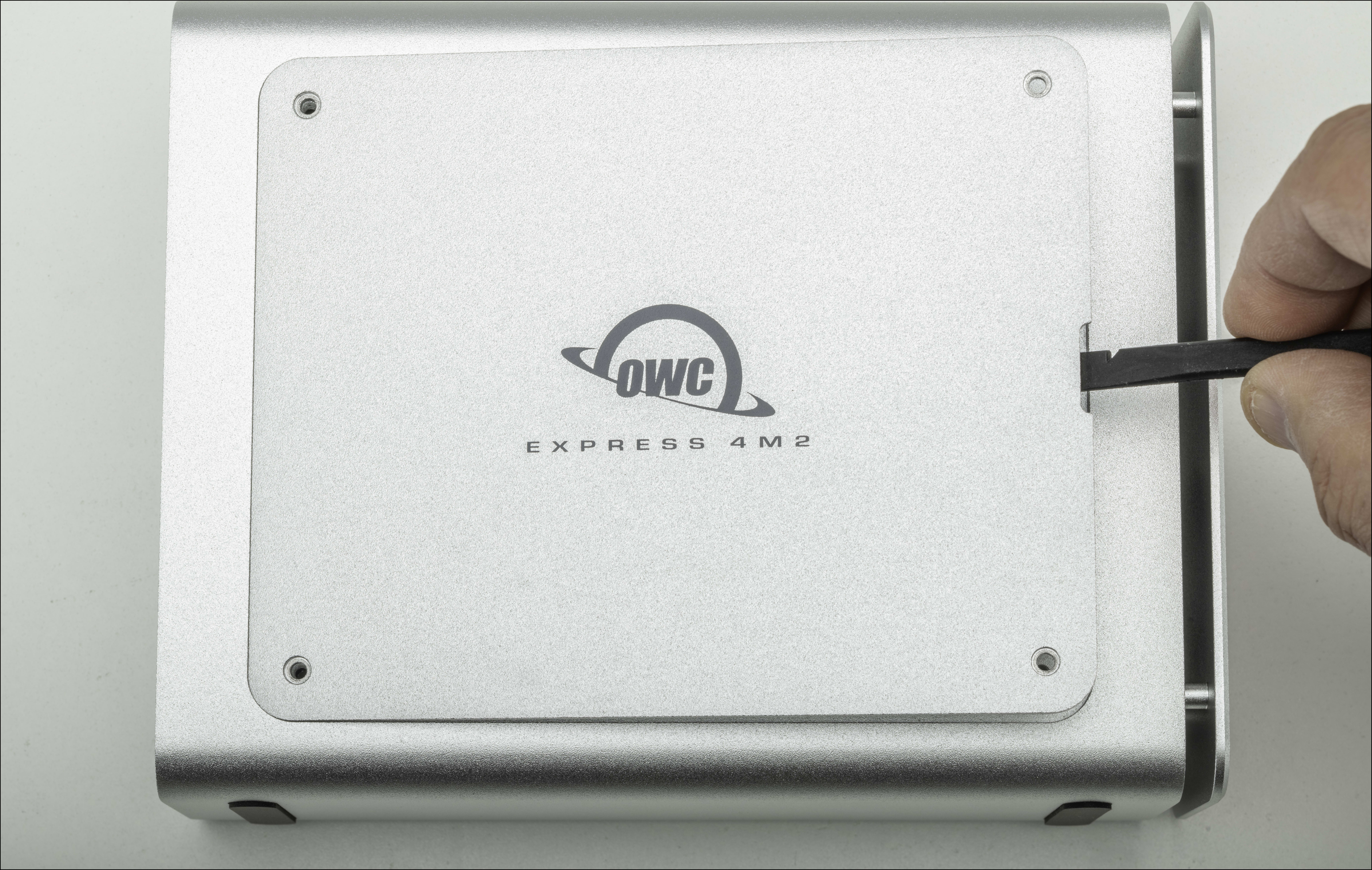
4. Carefully lift away the drive bay panel. This will provide access to the drive bays inside the enclosure
- NOTE: The underside of the drive bay panel has (4) thermal adhesive strips that cover the installed drives. Lay the drive bay panel down with the adhesive strips facing upwards to avoid obstructions adhering to the sticky strips.
- NOTE: Usage over time may result in the thermal pad sticking to the drives. When opening the device, carefully release and slowly separate the drive bay panel so the drives do not become damaged from the adhered thermal pads. Warming the device from usage before opening the device can help separate the thermal pads from the drives.
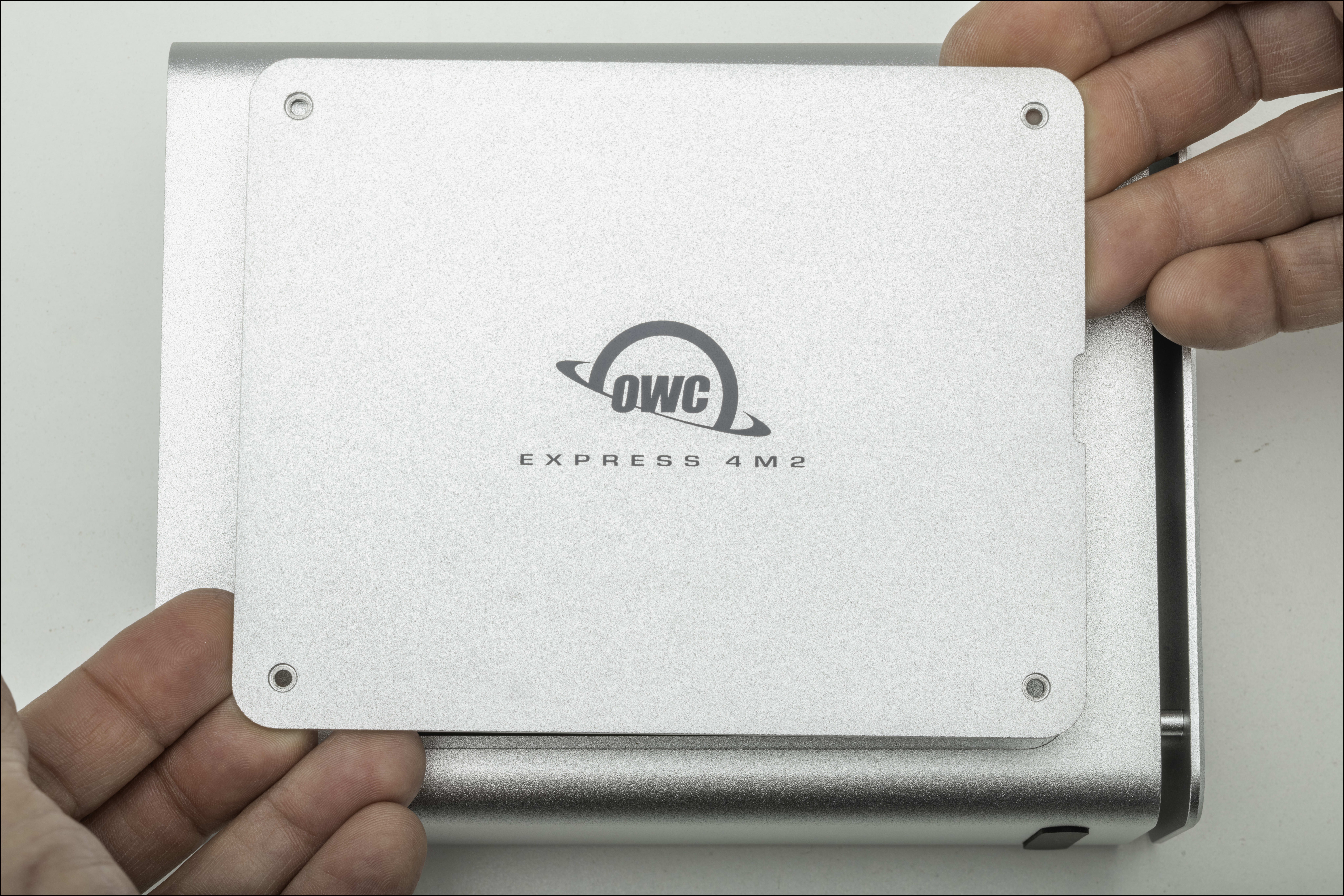
5. The OWC USB4 Express 4M2 supports 2280 | 2242 | 2230 NVMe M.2 SSD form factors. The image below identifies which column of drive post slots that should be used based on the desired form factor.
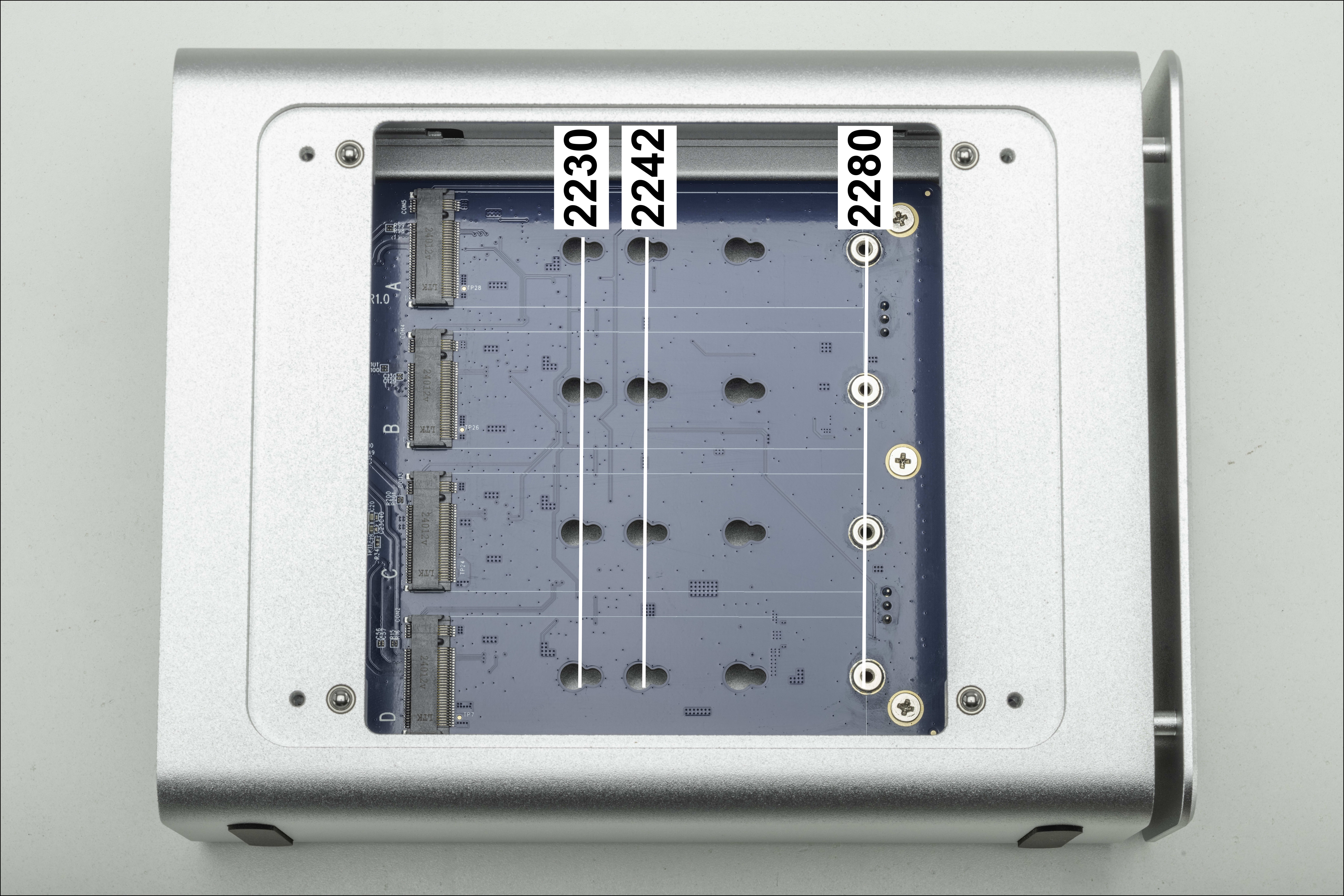
2280 Form Factor Installation
1. Remove the (4) 2280 form factor drive mounting screws.
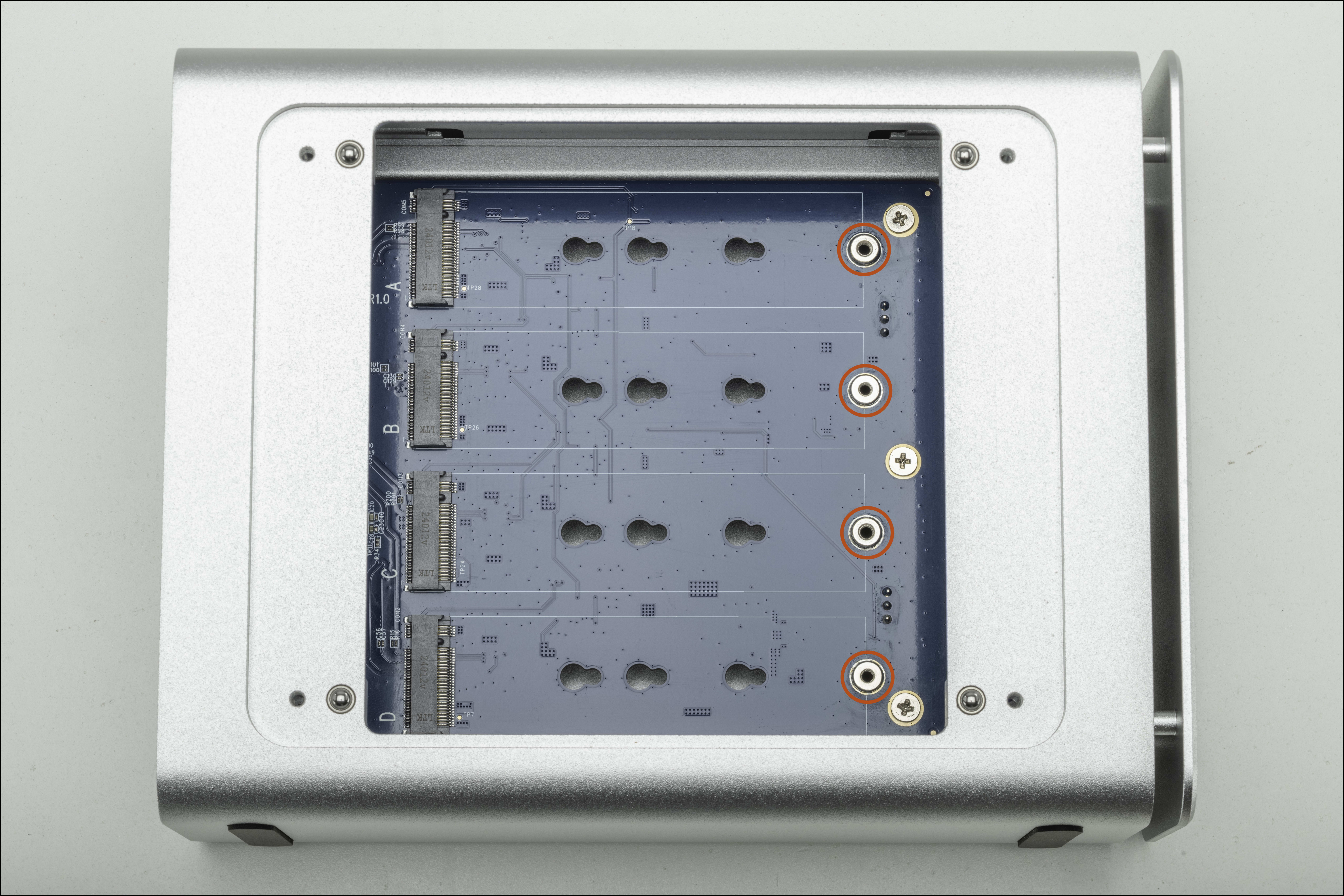
2. Carefully align the drive at a slight angle into the board connection and slide it forwards until fully connected.
- NOTE: Please do not force the drive into the board connection. Minimal force is required. Remove and realign the drive If resistance is felt.
- NOTE: The drive will rest at a slight angle when fully connected.
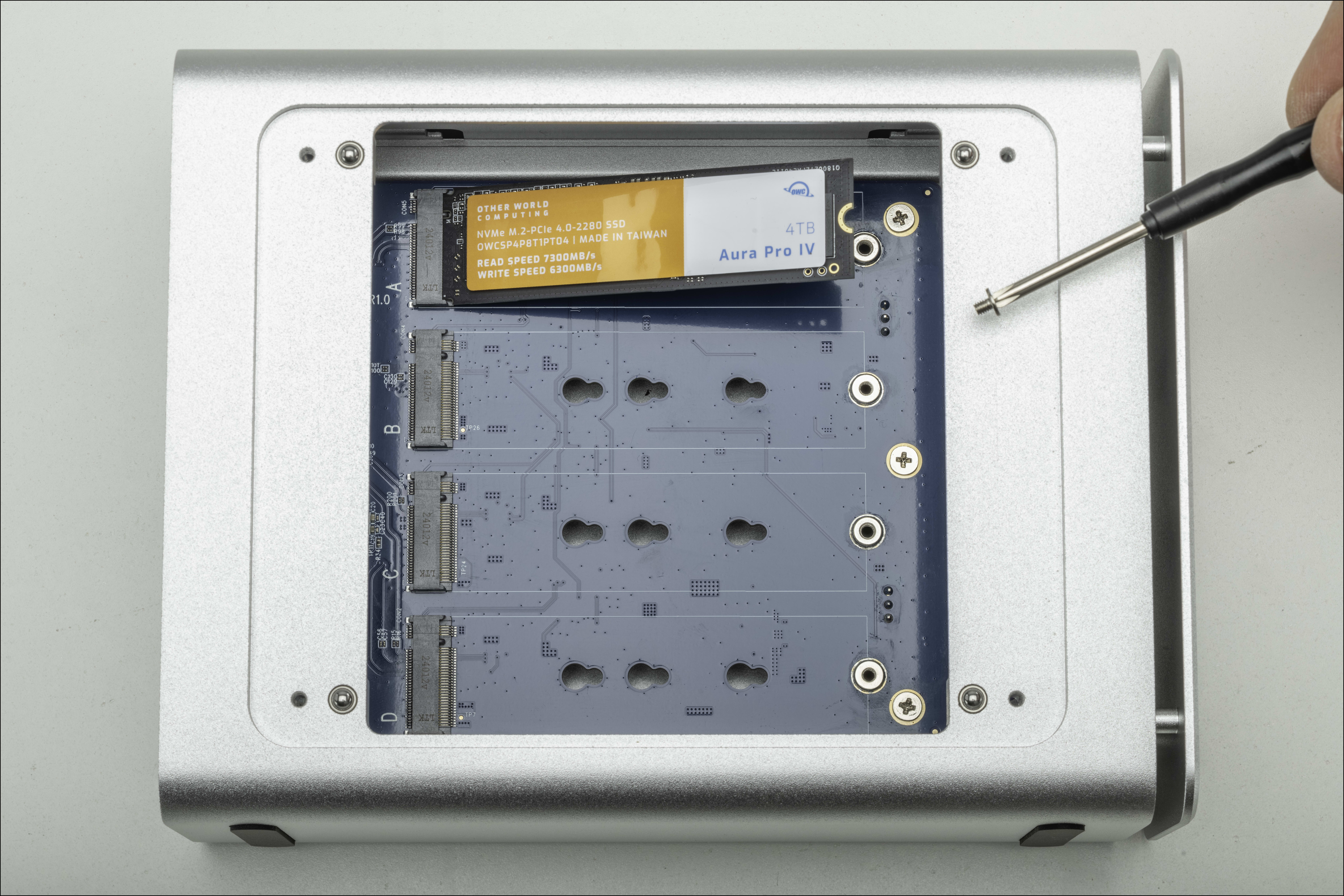
3. Press the drive down onto the board and use the removed 2280 form factor drive mounting screw from earlier to secure the drive.
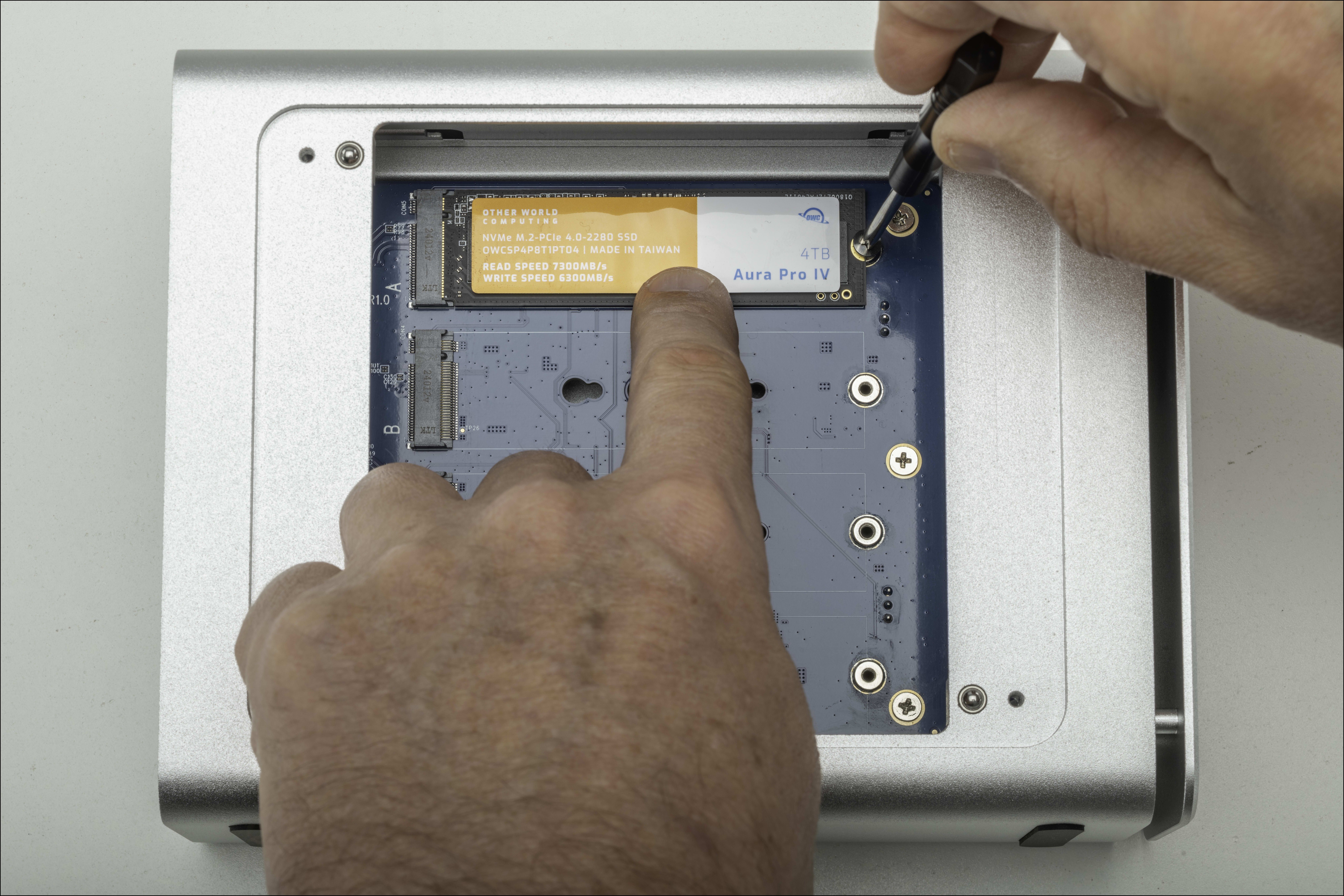
4. Repeat this process (3) additional times resulting in (4) installed 2280 NVMe M.2 SSDs.
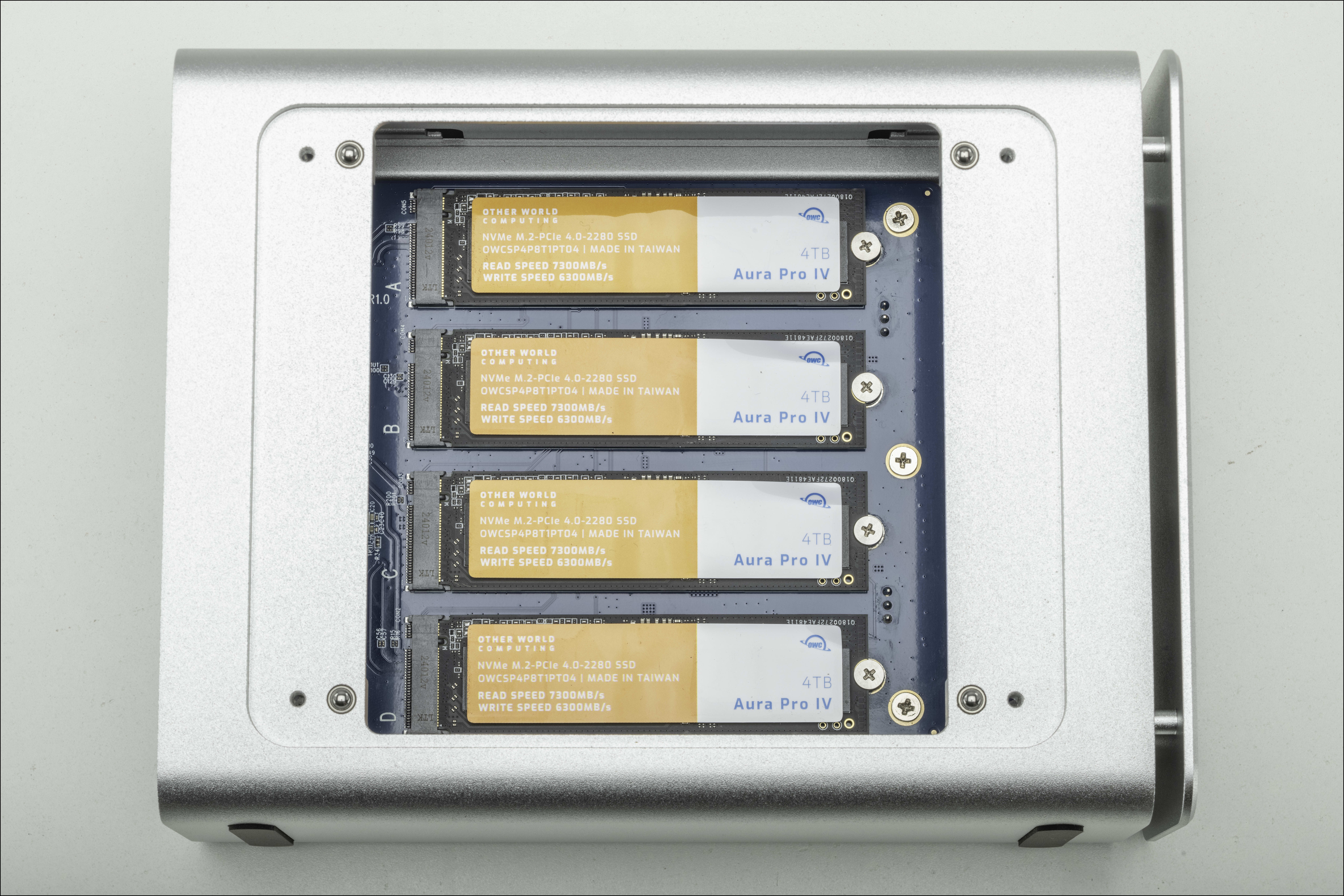
2242 | 2230 Form Factor
- These set of instructions illustrate the installation of a 2242 NVMe M.2 SSD.
1. Carefully place a drive mounting clip (included in baggie) into the larger portion of the drive mounting slot for the desired form factor.
- The arrow on the drive mounting clip should be pointing at the bottom of the device.
- NOTE: Be careful when placing the drive mounting clip. They are small and can slip through the drive mounting slot. The device will need to be turned upside down and carefully shaken to retrieve the clip.
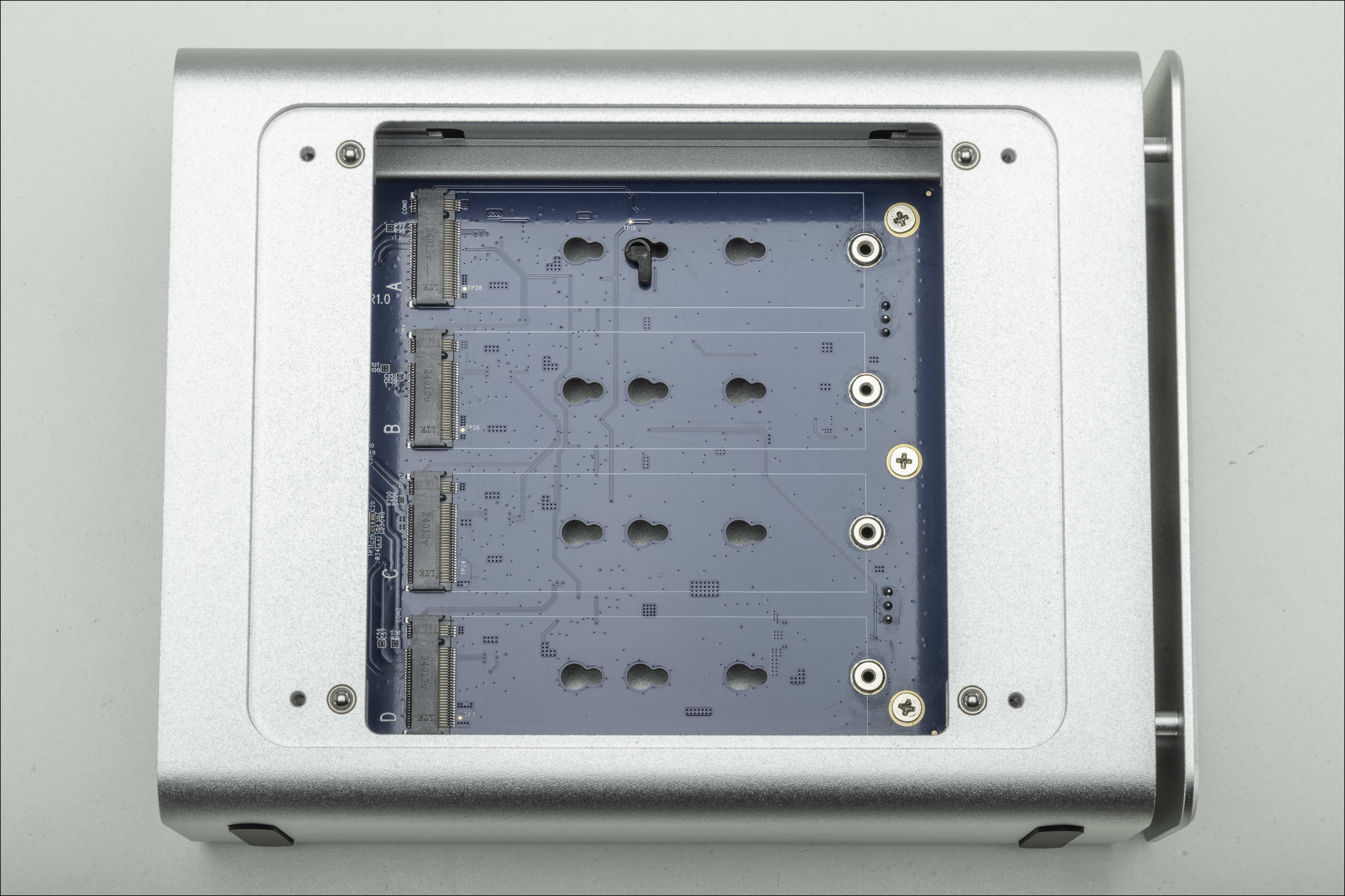
2. Slide the drive mounting clip into the smaller portion of the drive mounting slot.
- Rotate the clip counter-clockwise. The arrow of the clip should be pointing at the front of the device.
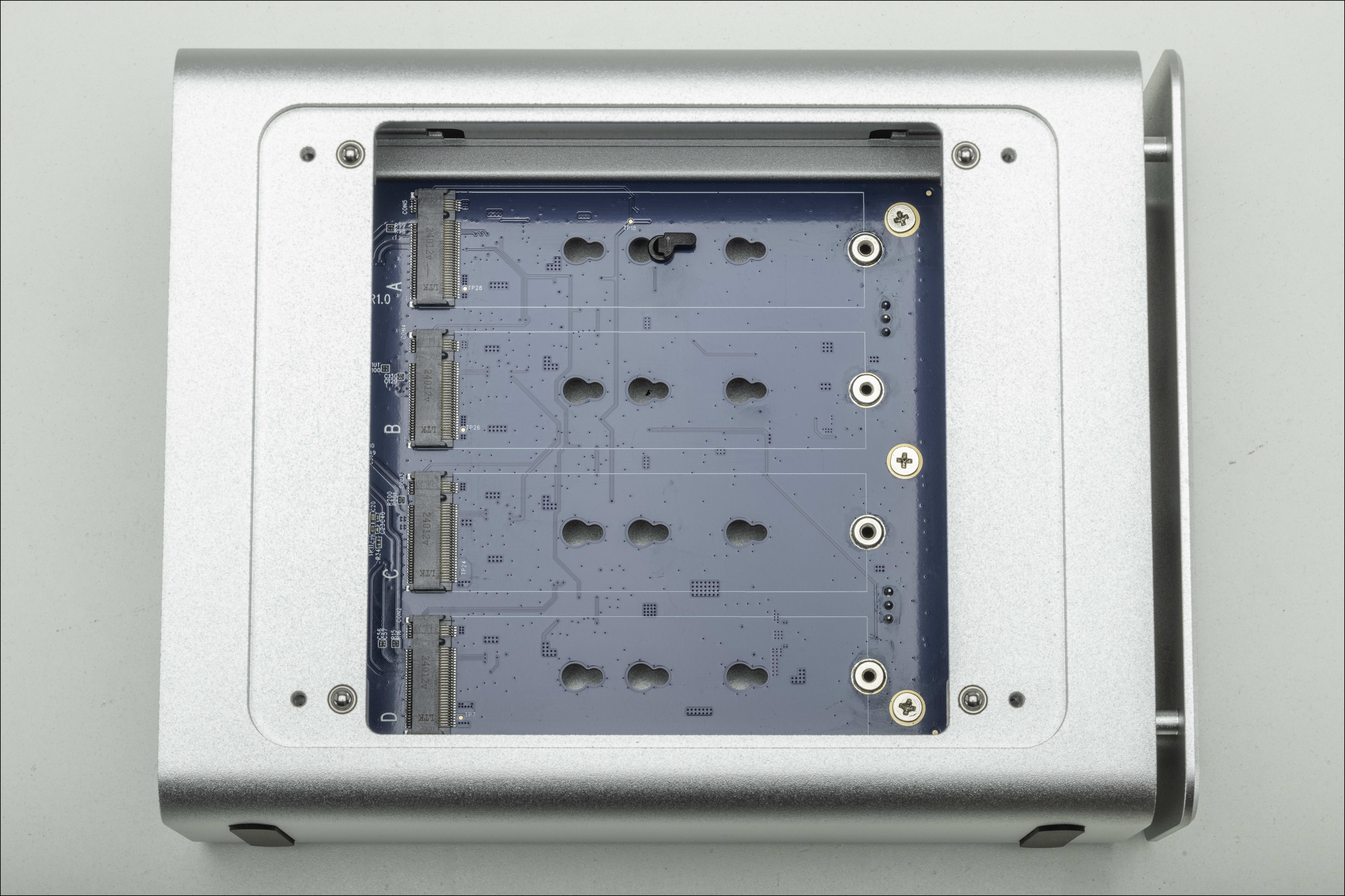
3. Carefully align the drive at a slight angle into the board connection and slide it forwards until fully connected.
- NOTE: Please do not force the drive into the board connection. Minimal force is required. Remove and realign the drive If resistance is felt.
- NOTE: The drive will rest at a slight angle when fully connected.
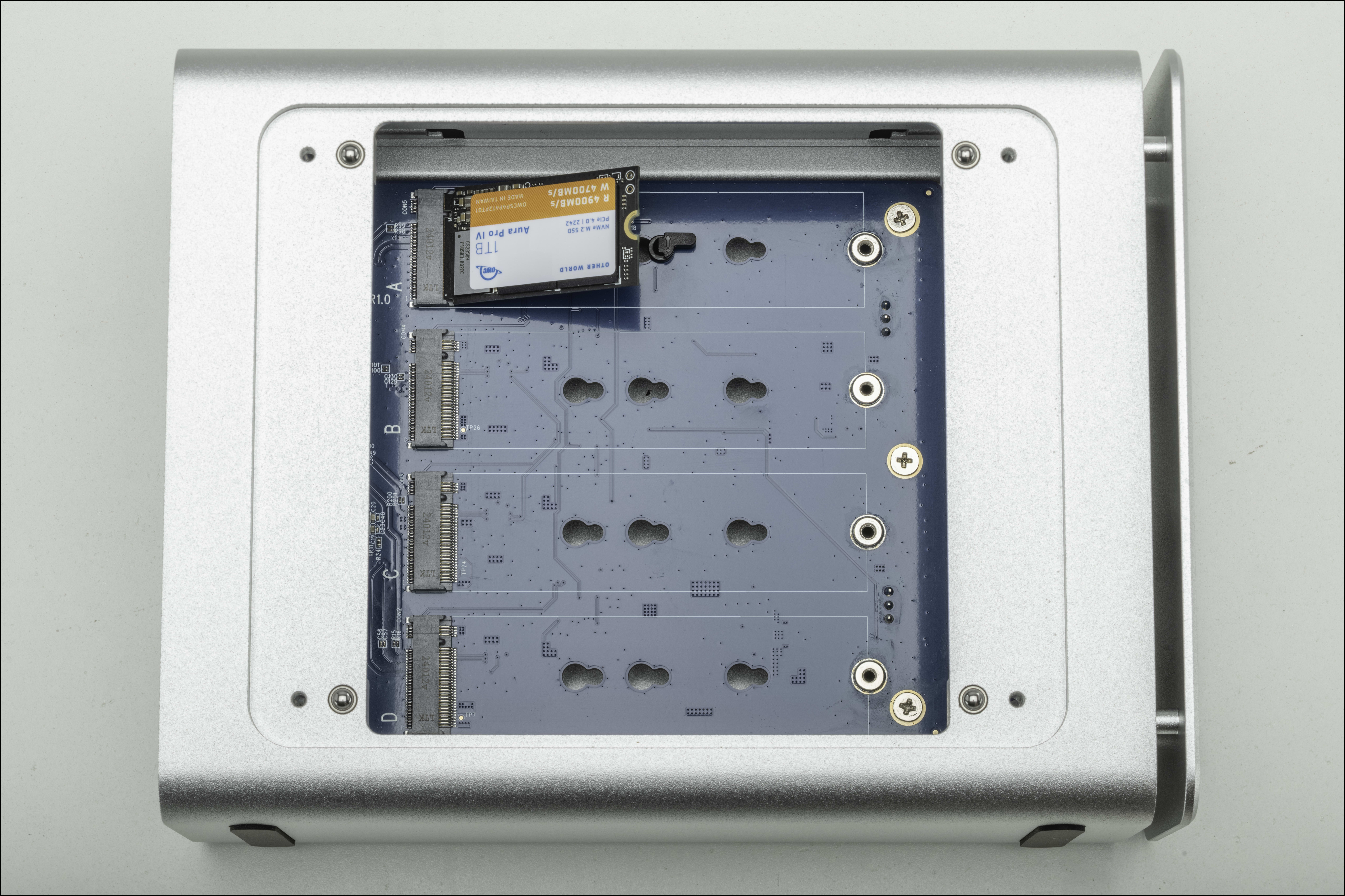
4. Slightly press the drive down onto the board and around the drive mounting clip.
- Rotate the drive mounting clip clockwise to secure the drive. The arrow of the clip should be pointing at the bottom of the device.
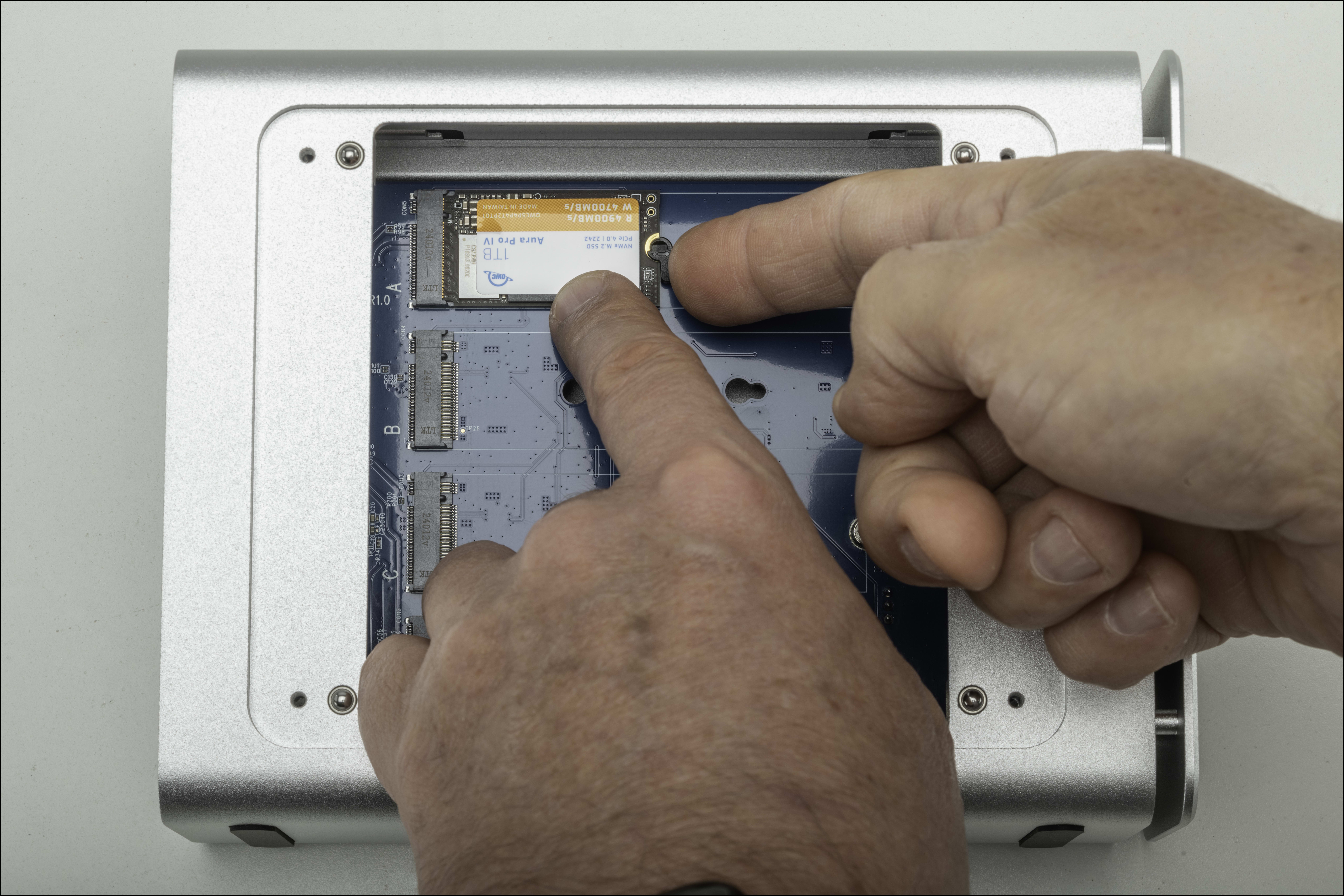
5. Repeat this process (3) additional times resulting in (4) installed 2242 or 2230 NVMe M.2 SSDs.
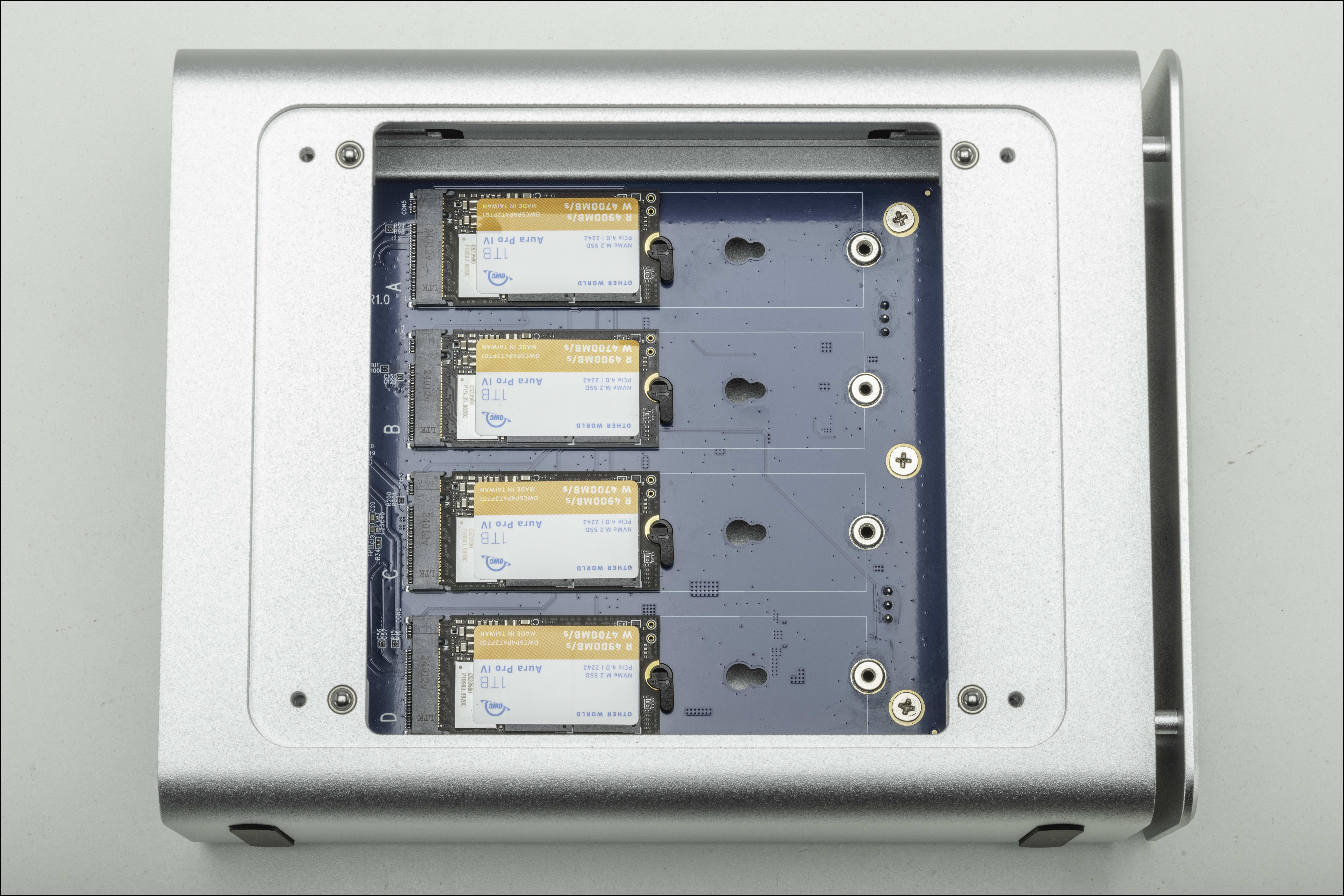
Closing the Enclosure
1. Align the drive bay panel over the drives and ensure the OWC logo is orientated to match the front OWC logo. Press down on the drive bay panel to ensure a strong bond with the NVMe M.2 SSDs.
- NOTE: The underside of the drive bay panel has (4) thermal adhesive strips that correspond and will cover the installed drives.
The thermal adhesive strips are covered with a protective film. Remove the protective film before proceeding with closing the enclosure.

2. Secure the drive bay panel using the (4) removed screws form earlier.
- OWC recommends attaching the aluminum vertical stand to stabilize the device while on a flat surface.

3. Connect the included 0.7M (28") USB-C 40Gb/s Cable into the USB4 40Gb/s Port and into a system.
4. The installed drives are ready to be formatted. OWC recommends creating a RAID volume for best performance.
- Section 2.2 “RAID Configuration Options” is the next section that will provide instructions on how to format and configure the drives in the OWC USB4 Express 4M2.
2.2 RAID Configuration Options
OWC SoftRAID RAID Configuration
- Select OWC USB4 Express 4M2 devices come bundled with "3 Years of SoftRAID Premium Access". Please visit OWC SoftRAID Product Details for more information regarding SoftRAID and the bundled Premium Access.
- NOTE: Downloading and installing the latest version of OWC SoftRAID is recommended to experience the best performance from the OWC USB4 Express 4M2.
- SoftRAID will assist with formatting the installed drives and setting up a RAID volume.
- NOTE: The OWC SoftRAID license is located on the OWC USB4 Express 4M2.
Mac OWC SoftRAID Setup
- Download OWC SoftRAID for Mac.
- Please review and follow the steps outlined in OWC SoftRAID Installation for Mac.
- Please review and follow the instructions outlined in Creating a macOS OWC SoftRAID Volume.
Windows OWC SoftRAID Setup
- Download OWC SoftRAID for Windows
- Please review and follow the steps outlined in OWC SoftRAID Installation for Windows.
- Please review and follow the instructions outlined in Creating a Windows OWC SoftRAID Volume.
Mac Software RAID Setup
1. Open the “Disk Utility” application on your Mac.
2. Choose “File” and select “RAID Assistant”.
3. Select a set type:
- Striped (RAID 0) set: A striped RAID set can speed up access to your data. You can’t create a RAID set on your startup disk; you must first start up your computer from another disk.
- Mirrored (RAID 1) set: Protect your data against hardware failure with a mirrored RAID set. When you create a mirrored RAID set, your data is written to multiple disks so the information is stored redundantly. You can’t create a RAID set on your startup disk; you must first start up your computer from another disk.
- Concatenated (JBOD) set: Increase storage space with a concatenated disk set. If you need one large disk, but you have several smaller disks, you can create a concatenated disk set to use as one large disk.
4. Select the checkboxes of the disks you want to include in the set.
5. For each disk, click the pop-up menu in the Role column and choose “RAID slice” or “Spare” to designate the disk as a standard member or spare in the set, then click "Next".
6. Enter a name for the RAID set in the RAID Name field.
7. Click the Format pop-up menu, then choose a volume format that you want for all the disks in the set. (See File system formats available in Disk Utility.)
8. Click the “Chunk size” pop-up menu, then choose a disk chunk size that you want used for all the disks.
- When you create a striped set, chunks of data from the same file are distributed across the drives. Ideally, you want data distributed across drives evenly and at an optimum size so that it can be efficiently accessed.
- If you want high data throughput from your set, choose a smaller chunk size so that data is spread across the drives and one drive can be accessing data while another is seeking the next chunk.
- With mirrored disk sets, choose a chunk size that matches the data you’re accessing. For example, when working with video files, your Mac is accessing large chunks of data, whereas when using a database of many small records, your disks may be accessing smaller chunks of information.
9. If you are creating a mirrored RAID set, select the “Automatically rebuild” checkbox to allow the set to be automatically rebuilt when member disks are reconnected
10. Click "Create" and then click "Done".
Device Management
3.1 USB Mode Switch
- The OWC USB4 Express 4M2 has a switch that can be toggled to change the device connection from the factory default USB4 40Gb/s connection type to a USB 3.2 10Gb/s connection type.
- NOTE: OWC recommends toggling the switch to the desired connection mode before connecting the device.
- Mac Users:
- USB4 40Gb/s Mode recommended for:
- Thunderbolt 5, Thunderbolt 4, USB4, and Thunderbolt 3 Intel based systems running macOS 15.x or later.
- USB 3.2 10Gb/s Mode recommended for:
- Intel based systems running macOS 14.x or earlier.
- USB 3.2 Gen 2 based systems.
- USB4 40Gb/s Mode recommended for:
- Windows Users:
- USB4 40Gb/s Mode recommended for:
- PC systems running Windows 11 or later.
- USB 3.2 10Gb/s Mode recommended for:
- PC systems running Windows 10.
- Thunderbolt 3 | USB 3.2 Gen 2 based systems
- USB4 40Gb/s Mode recommended for:
- Mac Users:
3.2 Drive Failure
- If the OWC USB4 Express 4M2 was configured as a RAID 0.
- The data on the array is lost and the disk is no longer usable.
- If the OWC USB4 Express 4M2 was configured as a RAID 5.
- The RAID can continue to be used, but the drive should be replaced immediately.
3.3 Replacing Drives
- A failed drive must be replaced with an identical drive (model, capacity, firmware). Refer above to section 2.2 “Assembly Steps” for drive replacement steps.
- To minimize the rebuild time, it is recommended to keep the device connected to the computer (with the computer powered on), and disable any drive sleep settings on the computer for the duration of the rebuild.
3.4 OWC Disk Performance
- As of Windows 10 v. 1809 the default Disk Removal Policy is ‘Quick removal’ instead of ‘Better performance’.
- NOTE: OWC storage solutions that are experiencing slow read/write speeds should consider checking and changing the Windows disk removal policy. Changing from "Quick removal" to "Better performance" can increase disk performance. OWC offers the application OWC Disk Performance to help change the Disk Removal Policy. Changing from "Quick removal" to "Better performance" can also be changed through OWC SoftRAID or manually through the operating system.
- Please review the support article Storage Solutions: OWC Disk Performance for additional details.
3.5 Manually Unmounting Volumes
To ensure no data is lost during normal use, always eject or unmount the corresponding volume(s) from the operating system before powering off and disconnecting the device. Unmounting options are provided below.
macOS
- Drag the icon for the device you wish to unmount to the trash can; OR
- Right-click the device icon on the desktop, then click “Eject”; OR
- Highlight the device on your Desktop and press Command-E.
Windows
- Windows 10 build 1809 (October 2018) or later:
- Eject the drive by clicking the ‘Show hidden items’ menu in the Taskbar, then clicking ‘Safely Remove Hardware and Eject Media’, and last select the ‘Eject’ option for this volume.
- Windows 10 build 1803 and earlier:
- Go to the System Tray (located in the lower right corner of your screen). Click on the “Eject” icon (a small green arrow over a hardware image).
- A message will appear, detailing the devices that the “Eject” icon controls, i.e., “Safely remove...” Click on this prompt.
- You will then see a message that says, “Safe to Remove Hardware.” It is now safe to disconnect the device from the computer.
3.6 Usage Notes
- To ensure no data is lost during normal use, always eject or unmount the corresponding disk(s) from your operating system before powering off the device.
- All four drive bays are bootable on macOS. SSDs with 512 byte sectors require macOS 10.13 or later.
- SoftRAID works with macOS 10.14 or later and Windows 10 or later. SoftRAID is licensed per computer. The SoftRAID serial number will work with both Mac and Windows but can only be active on one computer at a time.
- Additional seats can be purchased. RAID 4/1+0 (10) are currently Mac only at this time
- The OWC USB4 Express 4M2 has a switch that can be toggled to change the device connection from the factory default USB4 40Gb/s connection type to a USB 3.2 10Gb/s connection type.
- NOTE: OWC recommends toggling the switch to the desired connection mode before connecting the device.
- OWC recommends attaching the Aluminum Vertical Stand to stabilize the device while on a flat surface.
- Single drive performance up to 1600MB/s.
- Intel Mac system users connected over Thunderbolt 3 will experience Write Speeds up to 1500MB/s and Read Speeds up to 2500MB/s
- The underside of the drive bay panel has (4) thermal adhesive strips that cover the installed drives. Lay the drive bay panel down with the adhesive strips facing upwards to avoid obstructions adhering to the sticky strips.
- Usage over time may result in the thermal pad sticking to the drives. When opening the device, carefully release and slowly separate the drive bay panel so the drives do not become damaged from the adhered thermal pads. Warming the device from usage before opening the device can help separate the thermal pads from the drives.
- The OWC USB4 Express 4M2 has (2) 40mm fans for with variable cooling based on device temperature.
- < 35°C (FAN OFF)
- >= 35°C (FAN-PWM 40%)
- >= 45°C (FAN-PWM 60%)
- >= 50°C (FAN-PWM 80%)
- >= 55°C (FAN-PWM 100%)
Support Resources
4.1 Troubleshooting
- If your computer does not recognize the OWC USB4 Express 4M2 when it is connected:
- Verify the USB cable is securely connected between the OWC USB4 Express 4M2 and host system.
- Connect the OWC USB4 Express 4M2 and host system with a different USB4 cable.
- Connect the OWC USB4 Express 4M2 to a different host system.
- Verify the USB cable is securely connected between the OWC USB4 Express 4M2 and host system.
- Windows users experiencing slow read/write speeds should consider checking and changing the Windows disk removal policy.
- Please review the support article Storage Solutions: OWC Disk Performance for additional details.
- We are very sorry If issues continue to occur. Please know that OWC support is here to help.
- Contact information for our support can be found in section 4.4 "Contacting Support".
- Please have your serial number ready which is located on the bottom of the OWC ThunderBlade X8 and printed on the original packaging.
4.2 Online Resources
Support Articles:
- SoftRAID Quick Start Guide
- OWC SoftRAID Knowledgebase
- OWC SoftRAID Premium Access
- OWC Disk Performance Support Article
Downloads:
Product Pages:
4.3 About Data Backup
To ensure your files are protected and to prevent data loss, we strongly suggest that you keep two copies of your data: one copy on your OWC USB4 Express 4M2 and a second copy on either your internal drive or another storage medium, such as an optical backup, or on another external storage unit. Any data loss or corruption while using the OWC USB4 Express 4M2 (including with OWC SoftRAID) is the sole responsibility of the user, and under no circumstances may OWC, its parent, partners, affiliates, officers, employees, or agents be held liable for loss of the use of data including compensation of any kind or recovery of the data.
4.4 Contacting Support
4.5 About This Manual
The images and descriptions may vary slightly between this manual and the unit shipped. Functions and features may change depending on the firmware version or driver version, if applicable. Please visit the product web page for the most recent product information. OWC’s Limited Warranty is not transferable and subject to limitations.
General Use Precautions
- To avoid damage, do not expose the device to temperatures outside the following ranges:
- Environmental (Operating)
- Temperature (ºF): 32º — 104º
- Temperature (ºC): 0º — 40º
- Environmental (Non-Operating)
- Temperature (ºF): -4º — 158º
- Temperature (ºC): -20º — 70º
- Environmental (Operating)
- Always unplug the device from the electrical outlet if there is a risk of lightning or if it will be unused for an extended period-of-time. Otherwise, there is an increased risk of electrical shock, short-circuiting, or fire.
- Protect your device from excessive exposure to dust during use or storage. Dust can build up inside the device, increasing the risk of electrical shock, short-circuiting, or fire.
- Do not block any ventilation openings on the device. These help to keep the device cool during operation. Blocking the ventilation openings may increase the risk of electrical shock, short-circuiting, or fire.
Safety Precautions
- Use proper anti-static precautions when handling this device. Failure to do so can increase the risk of electrical shock or short-circuiting.
- Never expose your device to rain, or use it near water, or in damp wet conditions. Never place objects containing liquids on the device, as they may spill everywhere and into the openings. This will increase the risk of electrical shock, short-circuiting, fire, or personal injury.
- To avoid any risk of electrical shock, short-circuiting, fire, or dangerous emissions, never insert any metallic object into the device.
- Please cease use of the device and contact OWC Support if it appears to be malfunctioning.
Terms & Conditions of Sale
Warranty
The OWC USB4 Express 4M2 has a 2 Year OWC Limited Warranty. For up-to-date product and warranty information, please visit the product web page.
Changes
The material in this document is for information purposes only and subject to change without notice. While reasonable efforts have been made in the preparation of this document to assure its accuracy, OWC, its parent, partners, affiliates, officers, employees, and agents assume no liability resulting from errors or omissions in this document, or from the use of the information contained herein. OWC reserves the right to make changes or revisions in the product design or the product manual without reservation and without obligation to notify any person of such revisions and changes.
FCC Statement
Warning! Modifications not authorized by the manufacturer may void the user’s authority to operate this device.
NOTE: This equipment has been tested and found to comply with the limits for a Class B digital device, pursuant to Part 15 of the FCC Rules. These limits are designed to provide reasonable protection against harmful interference in a residential installation. This equipment generates, uses and can radiate radio frequency energy and, if not installed and used in accordance with the instructions, may cause harmful interference to radio communications. However, there is no guarantee that interference will not occur in a particular installation. If this equipment does cause harmful interference with radio or television reception, which can be determined by turning the equipment off and on, the user is encouraged to try to correct the interference by one or more of the following measures:
- Reorient or relocate the receiving antenna.
- Increase the separation between the equipment and receiver.
- Connect the equipment to an outlet on a circuit different from that to which the receiver is connected.
Copyrights And Trademarks
© 2025 Other World Computing, Inc. All rights reserved. OWC, the OWC logo, SoftRAID, and the SoftRAID logo are trademarks of New Concepts Development Corporation, registered in the U.S. and/or other countries. ThunderBlade is a trademark of Other World Computing, Inc. Mac and macOS are trademarks of Apple Inc. registered in the U.S. and in other countries. Thunderbolt and the Thunderbolt logo are trademarks of Intel Corporation or its subsidiaries in the U.S. and/or other countries. Microsoft and Windows are either registered trademarks or trademarks of Microsoft Corporation in the United States and/or other countries. Other marks may be the trademark or registered trademark property of their owners. No part of this publication may be reproduced, stored in a retrieval system, or transmitted in any form or by any means, electronic, mechanical, photocopying, recording or otherwise, without the prior written consent of OWC.
Free Support Chat
Our free award-winning support team is ready to answer all of your questions. Technical support is available Monday - Friday: 9AM - 6PM. Customer Support & Sales is available Monday - Friday: 9AM - 6PM. Support is unavailable on U.S. Federal holidays. Talk to a human today.

 1-800-275-4576
1-800-275-4576